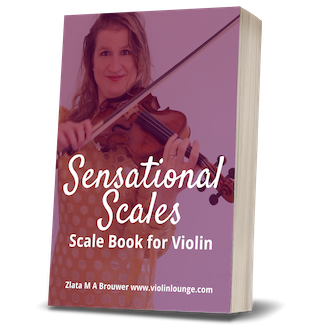How to Play in Tune on the Violin with Simon Streuff

How to improve your intonation on the violin?
The biggest struggle of violinists is to find and hit the right notes consistently
Improving your intonation is not just a matter of practicing more or listening well. You need some good practice strategies.
In the Violin Lounge Study Group on Facebook I asked you: if you could wave a magic wand and ONE area of your violin playing could be perfect, what area would you choose? Intonation (playing in tune) was most popular amongst you, so I decided to interview Simon Streuff all about intonation.
Simon is a performing violinist in Germany with a busy teaching studio and a successful YouTube channel. In this interview he shares tons of tips on improving your intonation, practicing scales and ‘cleaning up’ the pieces you already play.
Why is it so hard to play in tune?
Simon: On the violin it is especially hard because 3 factors that really play a role in the beginning of playing the violin.
- The violin hold is not very natural. You have to deal with a lot of stiffness in the beginning, a lot of muscle groups don’t really like the position and get stiff and inflexible.
- You have a very tiny instrument and the distances between the notes are very small.
- The approach to the violin is a lot about the ear. Actually playing in tune has a lot to do with different senses for example the heptical sense: measuring the distance between the fingers, and the hand-eye coordination when you want to read and play from notes fast.
Zlata: Yes I agree! My big breakthrough in playing the violin actually was at the conservatory when I talked with my teacher how you place your fingers, how your hand moves and to analyse that and to see how to get from one note to the other. Before that teachers told me that you need to relax your left hand as much as possible and play as soft as possible while you should actually hit the notes and play quite firmly.
Simon: If you play in an orchestra you cannot hear yourself that good so you have to be able to make a big position change just from sensing or just by looking at your fingerboard.
What do you think of products like fingerboard stickers and frets?
Simon: the fret thing is quite new to me. I know that a very famous violinist uses some kind of very small frets on his fingerboard. In generally I would say that when you put frets on your fingerboard you step away from the nature of the instrument which is you form the note with your fingertip. This is actually the beauty of the instrument that you can like a singer slide form one note to another. That is why I am not a big fan of frets. But stickers, when you are a beginner, there or not many ways around that. Stickers can really help you in the beginning to learn the finger position in the heptical sense and with the spacing between the fingers. So you get an idea of how the violin should sound. But please put them away as fast as you can.
Maybe the same goes for the tuner? Because a lot of people play a lot with the tuner on the violin or on the app?
Simon: A lot of students I hear actually do not play with a tuner because they think they can hear everything perfectly. And also the argument that when you play with an electric tuner it is in equal temperament so you don’t have the pure or just intonation. If you play out of tune then it is always better to play in equal temperament than to play out of tune. Also if you play with a piano or together or in orchestra you have to be very flexible with your left hand and have to have the ability to make micro adjustment. I think that can a tuner teach to you because they are so sensitive. Do not overdo it, a tuner is like a medicine. If you play with it 5 or 10 minutes a day it is enough.
Practicing scales do we need it and do you have some tips?
Simon: Yes of course, scales on the violin are quite important to practice. It is more important how you practice them then just do many of them every day and all day. With that I mean that you should focus on the details. You should focus on string changes, position changes and intonation. For that you can play them slowly without vibrato I would like to prefer. Before you get the intonation right it is not a good idea to play them very fast or with vibrato.
What do you think about ear training?
Simon: There are three ways to develop your ears:
- Active listening is like practicing harmony and theory and listing to intervals and to recognizing them and also the music memory if you hear a melody you can sing it and even write it down with the right intervals.
- Passive listening is quite enjoyable and is connected to a good concert. So you go to a good concert in a good hall and you got a kind of sense of where you want to go and when you practice you try to get there. I think this is quite equally important. The active ear training if someone can just identify the intervals it doesn’t mean he can play them beautiful and in tune.
- The third level is that you listen actively to a concert. So you listen and look for the harmonies and intervals and the interpretation also and getting better there and hearing more.
Zlata: Yes listen to recordings of pieces there is enough on Youtube. And outside live concerts, you can record your own music and listen to it.
Maybe other ways to improve your intonation? Or some other tips?
Simon: Yes I like to listen in between the notes. It is very common that you hear someone practicing a slow scale that for example he plays one note and maybe the next note is out of tune maybe too flat. And then he corrects it and plays on. I think it is very important to listen to the step between the notes so that you can hit the note on the target from the first moment the note sounds. For that you have to be reflective for yourself and not just correct it and go on. But you have to listen between the notes and take a step back. It is even more important when you talk about position changes.
Zlata: Even for beginners if you go from a 1st finger to a 3rd finger it is very different than going from a 4th finger to a 3rd finger. So you don’t really remember where the 3rd finger must be but if you come from a E string an d you have to go to a G string for example that is a totally different story.
How would you improve your intonation in the pieces that you currently play?
Simon: I have my usual tunes that I learned especially from my last teacher, she just said compare it with open strings. This is what you can do with nearly every note you play. You don’t have to have an octave you can also compare a quart or a fifth or a third. Also big intervals when you are high up on the E string you can compare it with an open A string. I think this is very important and also make a step back when you play. The other thing is that for example when you have a string change in a melody: for example when you go from a G to a B on the A string and you want to play that after each other. If you want to practice intonation from these notes, it is very helpful to play them together so they form the interval what they should form. When you play them together you can listen better to the intonation. I go through every piece, and when I get the feeling the intonation is bad, I do a cleaning routine. I play the piece through and every string place I do like double stops.
Zlata: I think that is why people think double stops are so difficult because they let you hear what you are doing wrong all the time.
Simon: When you play a melody you do not even hear how false your notes are.
Zlata: So always mistrust your intonation!
Thank you for being here and sharing your skills and knowledge!
Simon made a great course about intonation!
Learn to play in tune with Simon in his sweet, short and affordable course.
Get 15% off with the discount code zlata15
What’s the best insight you got from this interview? Is this video useful to you? Please let me know in the comments!
Love,
Zlata
PS: Do you want to see YOUR question answered in a Violin Lounge TV episode? Post a comment below!
FREE Violin Scale Book
Sensational Scales is a 85 page violin scale book that goes from simple beginner scales with finger charts all the way to all three octave scales and arpeggios
2 Comments
Trackbacks/Pingbacks
- Bow Control & Tone Creation (Simon interviews Zlata) - Violin Lounge - […] Simon is a performing violinist in Germany with a busy teaching studio and a successful YouTube channel. I interviewed him some time…


I’m an adult learner and at the beginning was given the option by my violin teacher of having dots on the finger board. I decided I would not do this. I think that was a good decision, because I am now getting the idea and developing finger positioning purely from muscle memory and listening. I do practice all the time with a tuner app: I find this incredible instructive, both to reassure when I think my tuning is good, and to correct when it is not. I am becoming less and less dependent on the tuner, as my ear starts to take over. I still rely on the tuner for pitching difficult-to-get notes (e.g. B-flat), but even this is becoming easier now. So for me – YES to a tuner and NO to fingerboard dots!
You’re absolutely right, Vernon, I think you’ve made a good decision from which you’ll benefit in the future as you develop your ear much more than someone playing with stickers. I never use stickers for my private students.